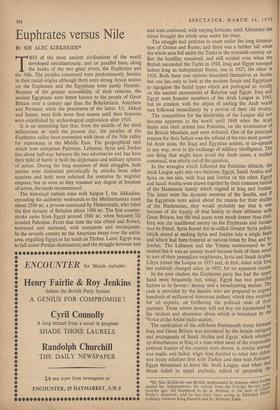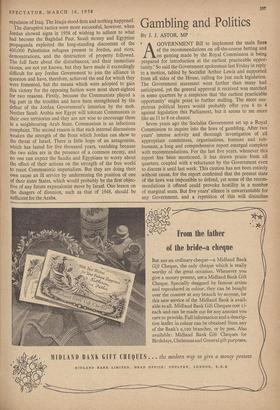Euphrates versus Nile
BY SIR ALEC KIRKBRIDE* TWO of the most ancient civilisations of the world developed simultaneously, and on parallel lines, along the banks of the two great rivers, the Euphrates and the Nile. The peoples concerned were predominantly Semitic in their racial origins although there were strong Aryan strains on the Euphrates and the Egyptians were partly Hamitic. Because of the greater accessibility of their remains, the ancient Egyptians were better known to the people of Great Britain over a century ago than the Babylonians, Assyrians and Persians; while the precursors of the latter, Ur, Akkad and Sumer, were little more than names until their histories were established by archmological exploration after 1918.
It is an interesting fact that, from the middle of the third millennium BC until the present day, the peoples of the Euphrates valley have contended with those of the Nile valley for supremacy in the Middle East. The geographical unit which now comprises Palestine, Lebanon, Syria and Jordan lies about half-way between the two adversaries and ha,s been their field of battle in both the diplomatic and military spheres of action. During the long sequence of their struggles, both parties were distracted periodically by attacks from other quarters and both were subdued for centuries by mightier empires, but as soon as they resumed any degree of freedom of action, the tussle recommenced.
The historical curtain rises with Sargon I, the Akkadian, extending his authority westwards to the Mediterranean coast about 2500 BC, a process continued by Hammurabi, who ruled • the first dynasty of Babylon about 1900 BC. The first counter- stroke came from Egypt around 1880 sc. when Senusret III invaded Palestine. From that time the tide ebbed and flowed, westward and eastward, with conquests and reconquests. In the seventh century Bc the Assyrians swept over the entire area, engulfing Egypt as far south as Thebes. Later, Egypt was to fall under Persian domination; and the struggle between east ••••••••••••••••••••••••••••••••• and west continued, with varying fortunes, until Alexander the Great brought the whole area under his sway.
The struggle had perforce to cease under the long domina- tion of Greece and Rome; and there was a further lull when the whole area fell under the Turks in the sixteenth century AD. But the hostility remained, and still existed even when the British succeeded the Turks in 1918. Iraq and Egypt emerged before long as independent States, one in 1927, the other in 1936. Both these new nations described themselves as Arabs, but one has only to look at the modern Iraqis and Egyptians to recognise the facial types which are portrayed so vividly on the ancient monuments of Babylon and Egypt. Iraq and Egypt were founder members of the Arab League in 1945. but its creation with the object of uniting the Arab world was followed immediately by a revival of their old rivalry.
The competition for the leadership of the League did not become apparent to the world until 1948 when the Arab States sent their armies into Palestine, on the termination of the British Mandate, and were defeated. One of the principal reasons for their failure was the refusal of the two most power- ful Arab units, the Iraqi and Egyptian armies, to co-operate in any way, even in the exchange of military intelligence. The one thing that might have saved the Arab cause, a unified command, was utterly out of the question.
In the wrangles which followed the Palestine debacle, the Arab League split into two factions; Egypt, Saudi Arabia and Syria on one side, with Iraq and Jordan on the other. Egypt and Saudi Arabia were drawn together by their common hatred of the Hashemite family which reigned in Iraq and Jordan. The latter were the dynastic enemies of the Saudis, and if the Egyptians were asked about the reason for their dislike of the Hashemites, they would probably say that it was because of the loyalty of that family to their alliances with Great Britain, but the real cause went much deeper than that; Iraq was the traditional enemy on the Euphrates and Jordan was its friend. Syria feared the so-called Greater Syria policy, which aimed at making Syria and Jordan into a single State and which had been fostered at various times by Iraq and bY Jordan. The Lebanon and the Yemen endeavoured to be neutral but it was an uneasy stand because both of them stood in awe of their immediate neighbours, Syria and Saudi Arabia, Libya joined the League in 1953 and, at first, sided with Iraq but suddenly changed sides, in 1955, for no apparent reason. In the past clashes, the Euphrates party has had the uPPer, hand most frequently but, today, Egypt has two powerful factors in its favour : money and a broadcasting station. The, cash is provided by the Saudis, who are prepared to expenn, hundreds of millions of American dollars, which they received for oil exports, on furthering the political ends of their partners. Those whom money will not buy are intimidated bY the virulent and shameless abuse which is broadcast by the `Voice of the Arabs' radio station.
The ratification of the still-born Portsmouth treaty between Iraq and Great Britain was prevented by the hostile intrigues and propaganda of Saudi Arabia and Egypt, which whipped up disturbances in Iraq at a time when most of the responsible political leaders of the country were absent. A similar attempt was made, and failed, wh,pn Iraq decided to enter into defers' sive treaty relations first with Turkey and then with Pakistan: Egypt threatened to leave the Arab League, and when thin threat failed to appal anybody, talked of proposing the *$ir Alec Kirkbride was British Ambassador in Amman when Jordanl gained her independence. He retired from the Foreign Service sorb months ago, but happened to, be in Amman at the time of Git1„3. Pasha's dismissal; and he has since been acting as Emissary D'" ordinary between King Hussein and Sir Anthony Eden. expulsion of Iraq. The Iraqis stood firm and nothing happened.
The disruptive tactics were more successful, however, when Jordan showed signs in 1956 of wishing to adhere to what had become the Baghdad Pact. Saudi money and Egyptian propaganda exploited the long-standing discontent of the 400,000 Palestinian refugees present in Jordan, and riots, demonstrations, and the destruction of property followed. The full facts about the disturbances, and their immediate causes, are not yet known, but they have made it exceedingly difficult for any Jordan Government to join the alliance in question and have, therefore, achieved the end for which they Were fomented, but the means which were adopted to gain this victory for the opposing faction were most short-sighted for two reasons. Firstly, because the Communists played a big part in the troubles and have been strengthened by the defeat of the Jordan Government's intention by the mob. Neither Saudi Arabia nor Egypt will tolerate Communists in their own territories and they are not wise to encourage them in a neighbouring Arab State. Communism is an infectious complaint. The second reason is that such internal discussions weaken the strength of the front which Jordan can show to the threat of Israel. There is little hope of an antagonism, which has lasted for five thousand years, vanishing because the two sides are in the presence of a common enemy, and no one can expect the Saudis and Egyptians to worry about the effect of their actions on the strength of the free world to resist Communistic imperialism. But they are doing their own cause an ill service by undermining the position of one of their sister States, which would probably be the first objec- tive of any future expansionist move by Israel. One lesson on the dangers of disunion, such as that of 1948, should be sufficient for the Arabs.



































 Previous page
Previous page